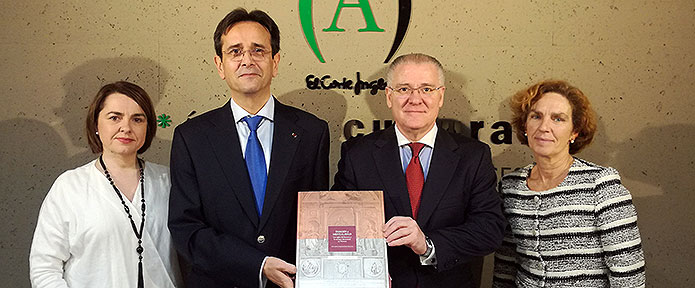2017-12-20-news-FYL-presentation-sanctuaries-land-estella
Ricardo Fernández Gracia presents his book "Imagen y mentalidad: Los siglos del Barroco y la estampa devocional en Navarra" (Image and mentality: The centuries of the Baroque and the devotional print in Navarra).
Published by the Ramón Areces Foundation, the work of the professor of the University of Navarra is now available at available download on the foundation's website.

The professor of the School of Philosophy and Letters of the University of Navarra, Ricardo Fernández Gracia, director of the Chair of Heritage and Navarrese art of the academic center, presented the book "Image and mentality: The centuries of the Baroque and the devotional print in Navarra", edited by the Ramón Areces Foundation, in the conference room of Ámbito Cultural of El Corte Inglés of Pamplona.
This monograph documents one hundred and thirty devotional engravings made by Pamplona silversmiths or by authentic foreign engravers from Madrid, Zaragoza, Rome or Valencia. The commissions from sanctuaries of such significance as Ujué, Aralar, Roncesvalles or San Gregorio Ostiense were aimed at spreading the cult of their titular images. Most of them are known copies of different printings, although in some cases only a single copy has been found. Likewise, a good issue of matrices have reached our days. Guilds, town councils, parishes, guilds, merchants and private individuals of different social status, aware of its significance and projection, ordered plates to be printed on colored silks, taffetas and various types of paper. Their use and function was multiple, since they served as authentic talismans, to postulate in Spain and America, to thank gifts of different kinds, to spread devotions, to serve as model to painted trompe l'oeil, and to illustrate printed matter such as patents, indulgence sheets and delicate thesis of Degrees.
From the 15th to the 19th century, prints have been the most important means of disseminating both images and ideas. Their most characteristic and singular feature is their multiplicity, since there is not a single copy, but numerous identical reproductions are made from a sheet or engraved copper plate. If we apply this characteristic to religious prints, known as devotional prints, we will see the primordial role they played in the training of the mentalities of the time and, therefore, how fundamental their knowledge is for the history of thought and art.
In the presentation of the book, which is available in the page of the foundation, were present Ms. Iciar Astiasarán, Vice President of research of the University of Navarra, Ms. Pilar Andueza, president of the Society of programs of study Historicals of Navarra and Mr. Juan José Cuns, director of El Corte Inglés, who attended on behalf of the Ramón Areces Foundation.

